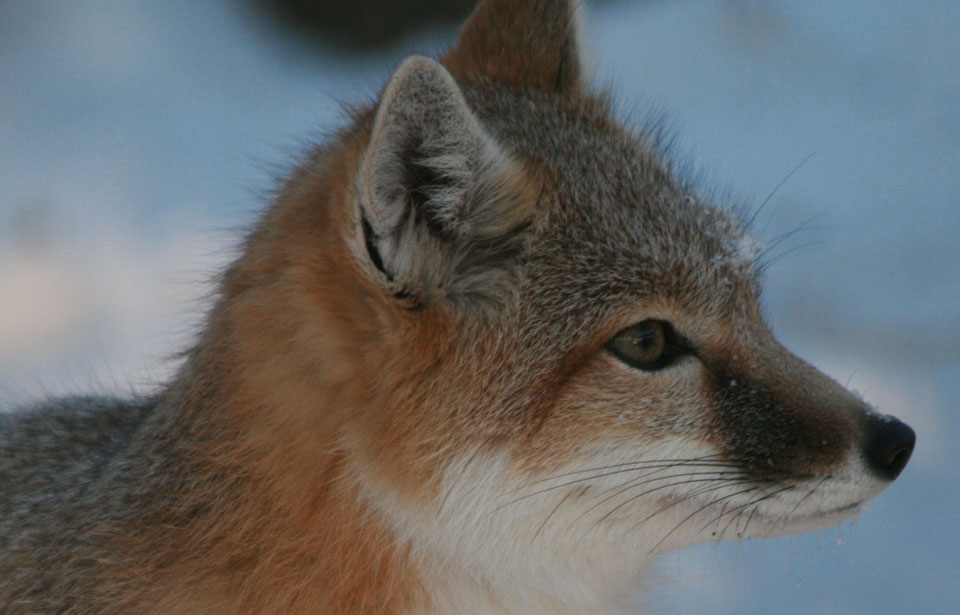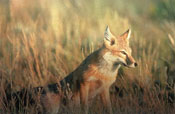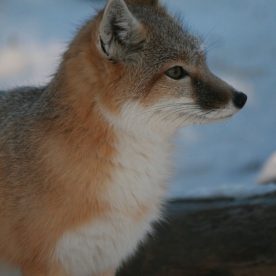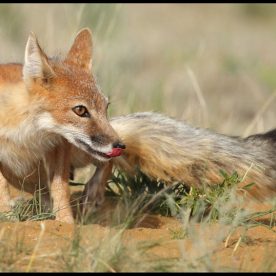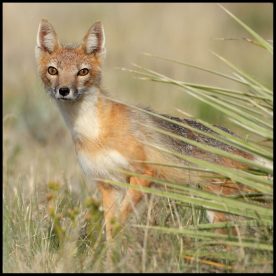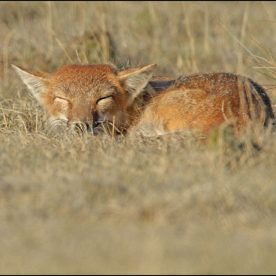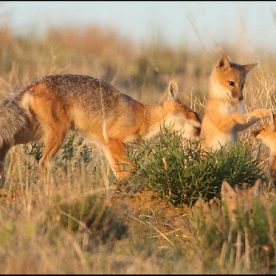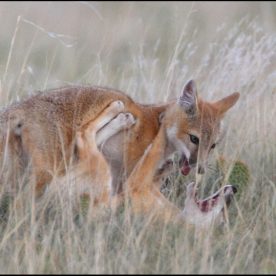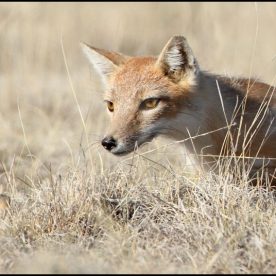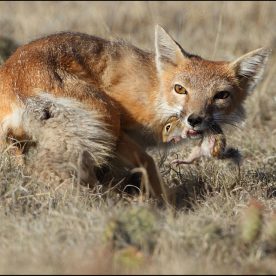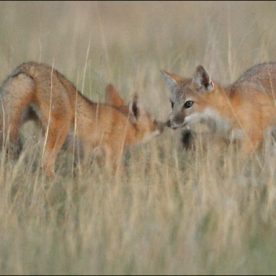Description
The swift fox (Vulpes velox), a member of the canid, or dog, family, is related to wolves, coyotes, dogs, and other foxes. It can be distinguished from other kinds of foxes found in Canada, such as red, arctic, and grey foxes, by its small size (it is about the size of a house cat), the black spot on each side of its nose, and its black-tipped tail.
In winter, the swift fox’s fur is long and dense, mainly buff-grey on the head, back, and upper surface of the tail, and orange-tan on the sides, legs, and lower tail surface. The throat, chest, and belly are light coloured (buff to white). In summer, the fur is short and coarse and more reddish grey.
Males are slightly larger than females, average weights being 2.45 and 2.25 kg, respectively. The animal stands about 30 cm high at the shoulder, and its total length is about 80 cm.
Early settlers of the Canadian plains knew the swift fox as the “kit” fox, and the two names have been used interchangeably since that time. However, studies of the prairie kit fox of Canada and the central United States and the desert kit fox of the southwestern United States showed that the two animals have some differences in appearance. Hence, the plains-dwelling species was designated the “swift” fox, and its desert cousin retained the name “kit” fox.
The swift fox can be distinguished from the kit fox Vulpes macrotis by its shorter, more widely spaced ears and its more rounded and dog-like head. The kit fox is broader between the eyes and has a narrower snout. The swift fox also has a slightly shorter tail, averaging of 52 percent of its body length compared with 62 percent for the kit fox.
Habitat and Habits
Swift foxes prefer open, sparsely vegetated short- and mixed-grass prairie, where visibility and mobility are unimpeded. Native vegetation common in such grasslands includes buffalo grass, bluestem, and wire grass. Conversion of native prairie grasslands to farmland has reduced both the quantity and quality of habitat available to the swift fox over much of its former range, although sizeable tracts of native grasslands still exist in parts of southern Alberta and Saskatchewan.
For swift fox populations to thrive, it is important that suitable den habitat be available. Dens are usually located on well-drained slopes and hilltops near permanent water bodies.
Swift foxes are mainly nocturnal, or active at night. Daytime activity is usually confined to the den area, although animals are occasionally observed farther afield in the morning or evening during the whelping season, when the young are born. If undisturbed, adults can often be observed sunning themselves near their dens, in the mornings or evenings during the summer and at midday during the winter.
Swift foxes have a low tolerance for wind. On windy days they are rarely seen above ground; this is true in summer as well as in winter.
Naturalist Ernest Thompson Seton described the swift fox as “the least cunning of our foxes.” Their curious nature and ready attraction to bait make them easily trapped and poisoned, which probably contributed to their eradication over much of their range in Canada in the early 1900s.
Unique characteristics
The swift fox gets its name from its speed. Individuals have been clocked at more than 60 km per hour, but the smallness of the animal fosters the illusion of even greater speed.
In the past, swift foxes were important to many Plains First Nations. Among the Blackfoot of southwestern Alberta, for example, the kit fox (the name the Blackfoot gave the swift fox) society ranked high in importance and performed sacred functions. At Buffalo Lake, near Stettler, Alberta, remains of swift foxes have been found in archaeological digs dating back several thousand years.
Unlike most other canids, swift foxes use dens throughout the year, both for protection and for giving birth to their young. Some dens, thought to be used mainly for protection, consist only of a single burrow and entrance; others used as whelping, or birthing, lairs are often very complex, a maze of interconnected tunnels with multiple entrances. The excavated dirt is usually pulled away from the entrance, often in a straight line. Although swift foxes will enlarge or modify ground squirrel or badger holes, they are fully capable of digging their own dens.
Range
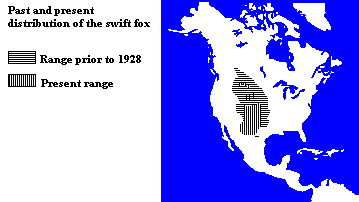 The Committee on the Status of Endangered Wildlife in Canada (COSEWIC) now considers swift foxes to be “endangered.” The species was once common across the plains of Canada, from the Pembina Hills in southwestern Manitoba to the foothills of the Rocky Mountains. In Alberta, swift foxes ranged as far north as 53° latitude, but in Saskatchewan and Manitoba they occupied more southerly plains regions.
The Committee on the Status of Endangered Wildlife in Canada (COSEWIC) now considers swift foxes to be “endangered.” The species was once common across the plains of Canada, from the Pembina Hills in southwestern Manitoba to the foothills of the Rocky Mountains. In Alberta, swift foxes ranged as far north as 53° latitude, but in Saskatchewan and Manitoba they occupied more southerly plains regions.
Feeding
Swift foxes are opportunistic predators, which means that they eat whatever is available. Their most important food items are mice, cottontail rabbits, and carrion, or dead and decaying animals, although they eat a range of other small mammals, birds, insects, reptiles, and amphibians. While the swift fox often has to rely on stealth and surprise to catch its prey, its speed occasionally enables it to catch a jackrabbit.
In summer, the diet of the swift fox reflects the greatly increased availability of a variety of prey species. Insects such as grasshoppers are frequently found in summer droppings, accounting for as much as 50 percent of the bulk. Although ground-nesting birds such as meadowlarks and Lark Buntings are also eaten, swift foxes do not appear to be major predators of game birds.
Breeding
Unlike most other canids, swift foxes use dens throughout the year, both for protection and for whelping pups, or giving birth to their young. Some dens, thought to be used mainly for protection, consist only of a single burrow and entrance; others used as whelping lairs are often very complex, a maze of interconnected tunnels with multiple entrances. The excavated dirt is usually pulled away from the entrance, often in a straight line. Although swift foxes will enlarge or modify ground squirrel or badger holes, they are fully capable of digging their own dens.
Swift foxes often live in pairs, although they may not mate for life. Males assist in capturing prey for their young, and both parents have been seen attempting to decoy a dog away from dens where young were present.
The breeding season occurs from January through March. The gestation period, or pregnancy, is approximately 50 days. Pups born in captivity in Canada are born from mid-April to mid-May. An average litter consists of four or five pups, but as few as one and as many as eight have been reported. The pups’ eyes and ears open at 10 to 15 days, and the pups are weaned at six to seven weeks. They have the appearance of adults by two months of age, and by September they are nearly as large as their parents are. Young foxes depart from the den where they were born sometime during the autumn.
The life span of swift foxes in the wild is eight to 10 years, although in captivity they have lived for up to 13 years.
Conservation
The fact that swift foxes appear to be dependent on dens throughout the year implies a need for protection in a habitat where cover is sparse. Coyotes, eagles, Red-tailed Hawks, and Rough-legged Hawks have been listed as enemies of swift foxes. However, it is humans that pose the most significant threat to the survival of the species, both directly, by hunting, trapping, and poisoning, and indirectly though destruction of suitable habitat.
Although frequently mentioned by early fur traders, swift fox pelts were never highly prized. The skins were considered too small and the fur too coarse to be of significant value. Naturalist Ernest Thompson Seton quoted prices ranging from $0.30 per pelt in 1906 to $8.35 per pelt in the boom years after World War I. Pelts sold in England were often dyed to imitate better-quality fox pelts.
In spite of their low value as furbearers, swift foxes are frequently caught in traps set for other more valuable species, such as red foxes and coyotes. They must therefore be managed, as are other furbearers.
During the 20th century, the swift fox disappeared completely from the wild in Canada. This happened quickly. Between 1853 and 1877, the Hudson’s Bay Company marketed an average of 4 681 swift fox pelts each year, but by the early 1920s the average annual take was down to 500 pelts. The last museum specimen was killed at Govenlock, Saskatchewan, in 1928.
In 1978, the Committee on the Status of Endangered Wildlife in Canada formally designated the swift fox as an “extirpated” species, and it was not downlisted to “endangered” until 1999. This recovery was accomplished by releases of captive-bred foxes and foxes taken from the wild in the United States.
Exactly why the swift fox vanished from the Canadian prairies is unclear. The replacement of native prairie grasslands by farms, which destroyed the fox’s habitat, was certainly one factor. Also, the species may have been the unintended victim of trapping and poisoning campaigns directed at other mammals, such as coyotes, wolves, and ground squirrels. However, despite the serious overall decline of the swift fox population in the United States and the eradication of the species in some states, the foxes managed to hold out in the central United States, where habitat change and trapping and poisoning campaigns were no less threatening than in Canada. Thus, severe winters and droughts in the northern part of the swift fox’s range were likely deciding factors in the disappearance of the swift fox in Canada.
The species has made a comeback in much of its United States range and has now reestablished a foothold in Canada.
In 1983, the Canadian Wildlife Service, in cooperation with the Faculty of Environmental Design, University of Calgary; the Wildlife Reserve of Western Canada, Cochrane, Alberta; the Calgary Zoo; the World Wildlife Fund (Canada); the Prairie Farm Rehabilitation Administration, Agriculture Canada; and the governments of Alberta, Saskatchewan, and Manitoba, initiated a program to reintroduce the swift fox to parts of its former range in Canada.
The foxes released were either caught in the wild in the United States or raised in captivity from breeding stock imported from the United States. Initially only the “soft” release method was used, in which pairs of foxes were penned and fed over winter at selected sites and released the following spring or summer. This technique allowed the foxes to become oriented to the release area. In addition, some pairs produced a litter of pups in the holding pens prior to release. Later, a second method, termed the “hard” release, was used, in which foxes that were old enough to disperse were taken from captive facilities in the fall and released directly into the wild. Preliminary data suggest that this method may be as good as or better than the soft release method.
Between 1983 and 1992, 136 foxes were released in soft releases and 507 foxes were released in hard releases. Low survival rates in the early years of a reintroduction are normal, and this experiment was no exception. Bad weather and predation by coyotes, bobcats, eagles, and owls accounted for most of the losses. However, studies to date have shown that released foxes can survive in the Canadian prairies: some have survived up to four years and have produced young. In 1991, an estimated 250 or more swift foxes were roaming wild and free in Canada, and the species was sighted or recorded as present in some other way (e.g., road kills) in at least 278 sections of land in southern Alberta and southern Saskatchewan. There were also 12 records of swift foxes in northern Montana between 1986 and 1992, and these foxes likely originated from the Canadian program.
Although the majority of the original stock of released foxes has perished, scientists are encouraged by the survival of a nucleus of second-generation foxes born and raised completely in the wild, and monitoring and releases will continue until several generations of foxes have been born. The population has increased, and the survivors have passed on common knowledge of den locations and food sources, a key element in the establishment of a viable population of swift foxes.
The ultimate aim of all participants in the reintroduction project is to see the swift fox become well enough established to permit its removal from the endangered species list. Such an event would mean that this interesting little canid will have been restored to its rightful place as part of Canada’s natural heritage.
Formed in 1986, the Swift Fox Conservation Society has greatly contributed to the success of this project. In addition to broad urban support, a core of local landowner support at the three release site areas has been important to the success of the program.
Resources
Print resources
Banfield, A.W.F. 1974. The mammals of Canada. University of Toronto Press, Toronto.
Carbyn, L.N., H. Armbruster, and C. Mamo. 1993. The swift fox reintroduction program in Canada from 1983 to 1992. In Restoration of endangered species. Cambridge University Press, Cambridge, U.K.
Chambers, G.D. 1978. Little fox on the prairie. Audubon 80(4):62–7.
Lynch, W. 1987. The return of the swift fox. Canadian Geographic 107(4):28–33.
Russell, R.H., and G.W. Scotter. 1984. Return of the native. Nature Canada 13(1):7–13.
Seton, E.T. 1929. Lives of game animals. Doubleday, Doran and Co., Garden City, New York.
© Her Majesty the Queen in Right of Canada, represented by the Minister of the Environment, 1983, 1988, 1993, 2001. All rights reserved.
Catalogue number CW69-4/68-2001E
ISBN 0-662-30955-3
Text: Richard H. Russell
Revision: L. Carbyn, 1993; S. Burns, 1999
Photo: L. Carbyn



